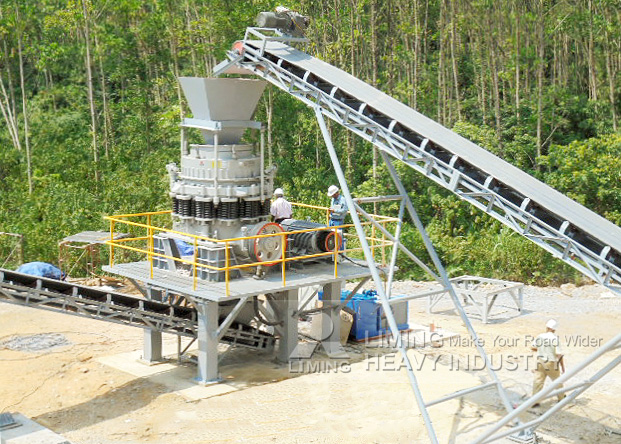How to Maintain a Cone Crusher in High-Temperature Environments: Essential Tips for Optimal Performance
Cone crushers are vital equipment in mining, quarrying, and aggregate industries, designed to crush hard materials efficiently. However, operating in high-temperature environments poses unique challenges, including accelerated wear, thermal stress, and lubrication breakdown. Proper maintenance becomes critical to prevent downtime and extend equipment lifespan. This guide provides actionable steps to maintain cone crushers in extreme heat while optimizing performance.
Why High Temperatures Threaten Cone Crushers
Before diving into maintenance strategies, understand how heat impacts cone crushers:
- Lubrication Degradation: High temperatures thin lubricants, reducing their ability to protect bearings and gears.
- Thermal Expansion: Metal components expand, causing misalignment and increased friction.
- Electrical System Stress: Motors and wiring may overheat, leading to failures.
- Material Buildup: Heat can cause sticky materials (e.g., asphalt) to adhere to crusher surfaces, reducing efficiency.

6 Key Maintenance Strategies for High-Temperature Environments
1. Optimize Lubrication Practices
Lubrication is the backbone of cone crusher maintenance. In high heat:
- Use High-Temperature Grease/Oil: Choose ISO VG 320 or higher viscosity oils designed for thermal stability.
- Monitor Oil Temperature: Install sensors to track oil temperature. Keep it below 60°C (140°F) to prevent oxidation.
- Increase Lubrication Frequency: Heat accelerates oil breakdown; replenish or replace lubricants more often.
2. Enhance Cooling Systems
- Install Auxiliary Coolers: Add oil coolers or heat exchangers to dissipate excess heat from the lubrication system.
- Improve Ventilation: Ensure the crusher’s motor and hydraulic systems have adequate airflow. Use fans or ducting to direct cool air.
- Shade the Equipment: Deploy sunshades or enclosures to reduce direct exposure to sunlight.
3. Regularly Inspect and Clean Components
- Check Bearings and Seals: Heat accelerates wear on bearings. Inspect them weekly for discoloration or roughness.
- Remove Material Buildup: Clean crusher chambers, mantles, and concaves daily to prevent material adhesion.
- Tighten Bolts and Fasteners: Thermal expansion can loosen components; re-torque bolts as per manufacturer guidelines.
4. Monitor Operating Parameters
- Track Crusher Load: Avoid overloading the crusher, as excess friction generates heat.
- Adjust CSS (Closed Side Setting): Slightly widen the CSS in extreme heat to reduce pressure on components.
- Use Thermal Imaging Cameras: Scan the crusher periodically to identify hotspots in bearings, motors, or hydraulics.
5. Upgrade Heat-Resistant Components
- Replace Standard Seals with High-Temp Variants: Nitrile or fluorocarbon seals withstand higher temperatures.
- Install Ceramic Liners: Ceramic-coated components resist wear and reduce friction-generated heat.
- Upgrade Electrical Systems: Use heat-resistant wiring and insulation for motors and control panels.
6. Implement Preventive Maintenance Schedules
- Daily Checks: Inspect oil levels, belt tension, and cooling systems.
- Monthly Servicing: Replace filters, test lubrication quality, and inspect wear parts.
- Annual Overhaul: Disassemble critical components to check for micro-cracks or warping caused by thermal stress.
Common Pitfalls to Avoid
- Ignoring Ambient Temperature: Even if the crusher is indoors, high ambient heat can affect performance.
- Using Generic Lubricants: Standard oils may not withstand prolonged high temperatures.
- Delaying Repairs: Minor issues like a leaking seal can escalate quickly in hot conditions.
Conclusion
Maintaining a cone crusher in high-temperature environments demands proactive measures, from selecting heat-resistant lubricants to upgrading cooling systems. By prioritizing regular inspections, optimizing lubrication, and leveraging technology like thermal imaging, operators can mitigate heat-related risks and ensure uninterrupted productivity. Adopt these strategies to protect your investment and maximize ROI in challenging conditions.
- > Tracked Mobile Cone Crusher in Recycled Aggregate Production from Construction Waste
- > Advantages of Impact Crushers in Limestone Mining
- > Mobile Crushers in Malaysia: Pioneering Iron Ore Grinding Solutions
- > Mobile Impact Crushers in Argentina: A Key Solution for Efficient Material Processing
- > VSI Vertical Shaft Impact Crusher for Particle Shape Optimization in Concrete Aggregates
- > The Impact of Quartz on Crushing Equipment
- > Can a Crawler Mobile Crushing Station Be Used for Construction Waste Recycling?
- > Choosing the Right Crusher for Volcanic Sandstone with a Hardness of 8-12 on the Rockwell Scale
Hot Product


Online




Message
